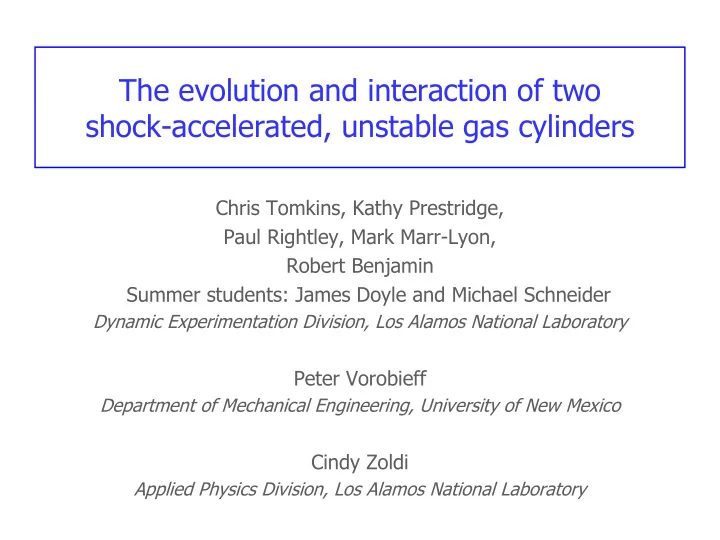

The evolution and interaction of two shock-accelerated, unstable gas cylinders Chris Tomkins, Kathy Prestridge, Paul Rightley, Mark Marr-Lyon, Robert Benjamin Summer students: James Doyle and Michael Schneider Dynamic Experimentation Division, Los Alamos National Laboratory Peter Vorobieff Department of Mechanical Engineering, University of New Mexico Cindy Zoldi Applied Physics Division, Los Alamos National Laboratory
PIV PIV Fog Fog generator generator IC Experimental setup: Gas cylinders shock tube SF 6 air air suction N Y D
Overview • Examine interaction of planar shock with 2 gas cylinders, separated spanwise. • S = 1.2D to 2.0D. Shock S (D = cylinder diameter) D • Goal: Investigate the evolution of the interacting, RM-unstable cylinders. Issues of interest include: • What is the effect of the interaction on the resulting flow morphologies? On the initial vorticity deposition? On the post-shock vortex development? • How sensitive is the flow evolution to the initial separation S?
Single shock-accelerated cylinder Double-cylinder “vortex blob” simulation (a) (b) (c) 8 8 8 7 7 7 Spanwise Spanwise Spanwise 2D 6 6 6 5 5 5 2 1 0 -1 -2 2 1 0 -1 -2 2 1 0 -1 -2 Streamwise Streamwise Streamwise
Double-cylinder interaction: weak S � 2.0D Shock S � 1.8D
Double-cylinder interaction: moderate S � 1.6D Shock S � 1.5D
Double-cylinder interaction: strong S � 1.4D Shock S � 1.2D
PIV images: double cylinder Two-frame cross-correlation, flow left to right, 6 th pulse • • S = 2.0D. Note non-uniform seeding. t o t 1 Shock
Double-cylinder velocity field: PIV 12 10 • Double-cylinder data, 6 th pulse, 10 m/s S = 2.0D 8 • Two-frame cross- 2 + v' 2 ) 1/2 (u' correlation z (mm) (m/s) 6 40.0 (Christensen et al., 35.0 2000) 30.0 25.0 20.0 4 • Not smoothed 15.0 10.0 • Contours are 5.0 fluctuating velocity 2 magnitude 0 Shock 12 10 8 6 4 2 0 x (mm)
Double-cylinder vorticity field 12 • Same realization 11 • Vorticity 10 contours � y (1/s) 9 • Not smoothed 60 8 48 36 7 24 z (mm) 12 Shock 6 6 4 -4 5 -6 -12 4 -24 • And the ratio of -36 3 -48 circulations is -60 2 � outer 3 1 � 0 12 10 8 6 4 2 0 � inner x (mm)
Correlation-based ensemble averaging Match one image (template) to each individual realization. Desire optimum match between template 2 and image, i.e. minimize mean sq. error: e I ( x ) I ( x x ) dA o � t � � � x This requires maximizing I ( x ) I ( x x ) dA w.r.t. o o � t � � D Do for each realization, then extract and average (Soloff, 1997) Yields cond. avg.: I ( x x ) | x o o � � � This avg. becomes the new template. I t Properties: x D -Minimizes dependence on initial choice of template. x I o -Converges quickly.
Correlation-based ensemble average S � 1.2D, Ensemble average Shock S � 1.2D, Individual realization
Fluctuating intensity fields, S = 1.2D t 750 s t 470 s � � � � Total Fluctuating Total Fluctuating
RMS of fluctuating intensity RMS Intensity vs. Time for several values of S/D. 40 RMS of Initial Conditions 35 1.5 1.4 30 1.3 RMS intensity, � I Normalized IC RMS Intensity 25 1.2 Mean 1.1 20 1 0.9 15 0.8 S/D = 1.2 S/D = 1.4 10 0.7 S/D = 1.5 S/D = 1.6 0.6 S/D = 1.8 5 S/D = 2.0 0.5 1.2 1.4 1.6 1.8 2 S/D 0 0 100 200 300 400 500 600 700 800 Time after shock passage ( � sec)
Small-scale activity: single cylinder 800 � m A 12 10 A 8 Streamwise (mm) 6 1.0mm B 4 2 B 0 2 4 6 8 10 Spanwise (mm)
Vorticity and swirling strength 12 12 11 11 10 10 9 9 � z 8 (1/s) 8 � ci Streamwise (mm) Streamwise (mm) 50 300 7 7 40 200 30 100 6 6 20 -100 10 -200 -10 5 5 -300 -20 -30 4 4 -40 -50 3 3 2 2 1 1 0 0 0 5 10 0 5 10 Spanwise (mm) Spanwise (mm)
Conclusions • The degree of cylinder-cylinder interaction, and hence the resulting flow morphology, is highly sensitive to the initial cylinder separation. • Different separations may lead to weak, moderate, or strong interactions. • An idealized “vortex blob” simulation leads to very different flow morphologies than experiment, suggesting that the inner vortices are weakened by interaction. • Vorticity fields calculated from high-resolution PIV measurements confirm that the inner vortices are significantly weaker, even for S/D = 2.0: / 3 � � � outer inner
Conclusions • A correlation-based ensemble averaging procedure effectively captures the large and intermediate scales of the flow, providing confirmation of the experimental repeatability, and permitting decomposition of the density field into mean and fluctuating components. • The RMS intensity fluctuations based on this decomposition are substantially greater for the case of “moderate” interaction than for the “strong” or “weak” interaction cases, despite comparable initial RMS values. • High-resolution PIV data resolves mm-scale vortices being convected around the vortex cores.
Recommend
More recommend